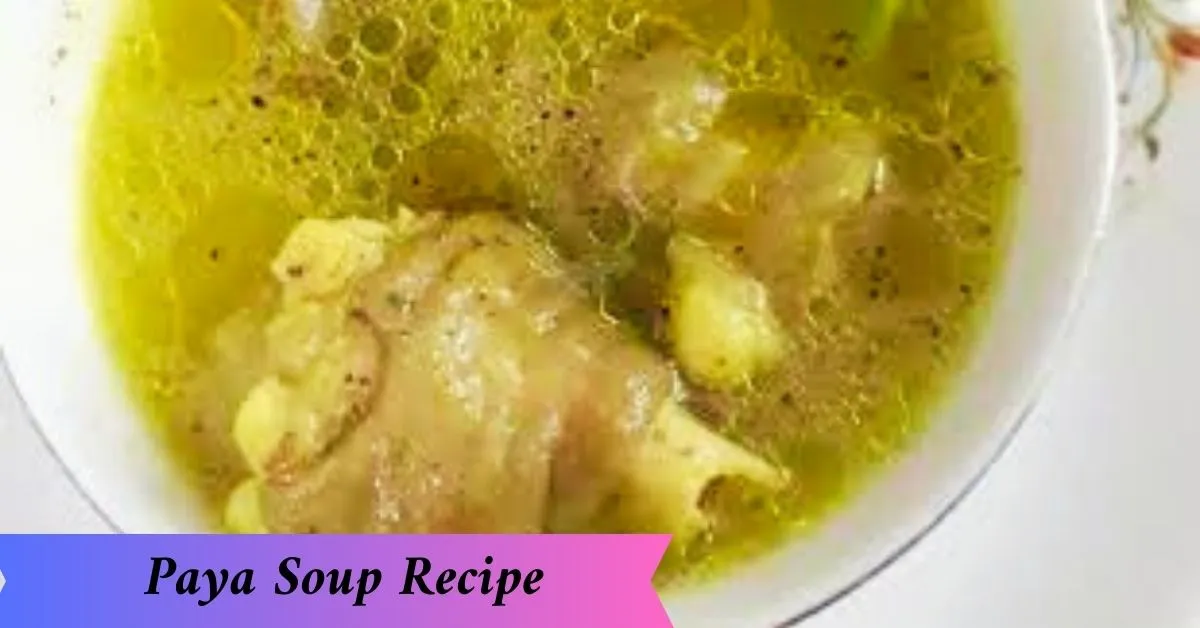Under the name “Paya Soup Recipe” or “Paye ka Shorba,” a nourishing and celebrated soup from the Indian subcontinent is enjoyed. The savory delight has charmed food connoisseurs both locally and globally. A delicious goat trotter soup, carefully prepared with aromatic spices, results in a highly nutritious and gratifying culinary experience.
Paya Soup Recipe
An age-old recipe for Paya Soup involves cooking goat feet in a broth with other meat and spices. The lengthy cooking time permits the taste buds to blend, resulting in a delicately textured and alluring broth. The juicy bits from the joints and bones elevate the soup’s flavor, rendering it a mouthwatering pleasure.
The History of Paya Soup Recipe
The history of Paya Soup dates back to the Mughal period in South Asia. The historical kitchen was responsible for whipping this delectable treat during the king’s reign. Across the ages, its popularity has spanned geographical frontiers and won hearts globally.
Health Benefits of Paya Soup Recipe
Rich in Nutrients
Paya Soup is a powerhouse of essential nutrients like protein, collagen, calcium, and iron. This choice offers exceptional benefits for those desiring to enhance their health and happiness.
Boosts Immunity
Paya Soup’s abundant nutrition promotes the immune system’s health, allowing it to easily combat infections.
Improves Digestion
The gelatin content in Paya Soup provides digestive support and bolsters gut well-being, thereby rendering it an optimal selection for individuals struggling with digestive problems.
How to Make Paya Soup Recipe
Ingredients
To prepare Paya Soup, you will need:
- Goat trotters and meat
- Onions
- Tomatoes
- Ginger-garlic paste
- Among these whole spices are cinnamon, cloves, and cardamom.
- Some ground spices that can be found are turmeric, red chili powder, and coriander powder.
- Ghee or oil
- Water
- According to preference, add salt and pepper here.
Cooking Method
Carefully scrub the goat parts to eliminate all filth. In this pot, combine the selected oil or ghee with whole spices, allowing the mixture to infuse its captivating aroma. Sauté onions until they transform into a golden brown color. Combine the ginger and garlic and sauté briefly before finishing. Integrate the tomatoes into the dish, allowing them to soften through heat exposure. Mix in the ground spices and continue cooking until the oil partitions. Mix the goat trotters and meat, enabling them to sear briefly. Add sufficient liquid to coat the components, then let it simmer.
Allow the heat to diminish gradually while keeping the lid fixed over the pot, permitting the meat to soften progressively and the essences to unite deeply. Taste-wise, you can season to preference. Bold and flavorful Paya Soup is best enjoyed with selected garnishes.
Variations of Paya Soup Recipe
Regional Differences
As Paya Soup expanded into diverse areas, it evolved to suit regional culinary inclinations. Each locality contributes its special flair to the classic dish, infusing it with eclectic tastes.
Vegetarian Alternatives
Providing a vegetarian option, some imaginative recipes incorporate potatoes or mushrooms as a meat substitute, resulting in a delicious meatless Paya Soup.
Serving and Presentation
Paya soup can be a calming introduction to a meal or a satisfying conclusion. It enjoys harmonious pairings with an assortment of bread products, such as newly baked naan, crunchy bread, and scent-filled rice.
Paya Soup and Cultural Significance
Beyond its taste, Paya Soup holds symbolic value within the culture. This beloved meal is often served at festive gatherings, evoking sentiments of gladness, kinship, and commemoration.
Popular Accompaniments
The meal transcends its rich flavor profile by pairing Paya Soup with complementary herbs and spices. The extra components breathe new life into the culinary experience.
How to Make the Best Payas Soup Ever
- Patience is Key: Allow the soup to sit and combine its flavors over a lengthy cooking time on low heat.
- Skim the Fat: Avoid excess fat to create a more appealing and nutritious soup.
- Slow Cooking: These kitchen appliances enable tender and delicious food preparation.
- Fresh Ingredients: You can enrich the soup’s flavors by picking new and first-rate materials.
Paya Soup in Different Cuisines
The global appeal of Paya Soup has fostered its incorporation into an array of diverse food cultures. Various civilizations have adapted and modified the recipe, each contributing their culinary expertise.
Conclusion
Ultimately, Paya Soup exemplifies the magnificence of taste and the magic of long, slow cooking. This meal holds immense cultural value and symbolism, elevating it beyond culinary indulgence. The culinary adventurer with a penchant for fine flavors will find Paya Soup a delectable indulgence.
Frequently Asked Questions (FAQs)
Q: When is the ideal moment to relish Payas soup?
A: Paya Soup reaches its peak flavor during the chilly winter seasons, providing a soothing respite from the cold.
Q: Can I freeze Paya Soup?
A: Freezing Paya Soup is possible without compromising its flavor or quality. Keep it sealed and thaw it correctly before reheating.
Q: Does Paya Soup come in a plant-based variety?
A: Some innovative recipes use vegetables like potatoes or mushrooms as a substitute for meat, creating a delightful vegetarian Paya Soup.
Q: Could I replace goat with lamb or chicken in this dish?
A: Goat meat is the standard ingredient, but you may explore utilizing lamb or chicken if you wish to diversify.
Q: Can Paya Soup aid in joint care?
A: Confirming the collagen content of Paya Soup, which can contribute to improved joint well-being.

